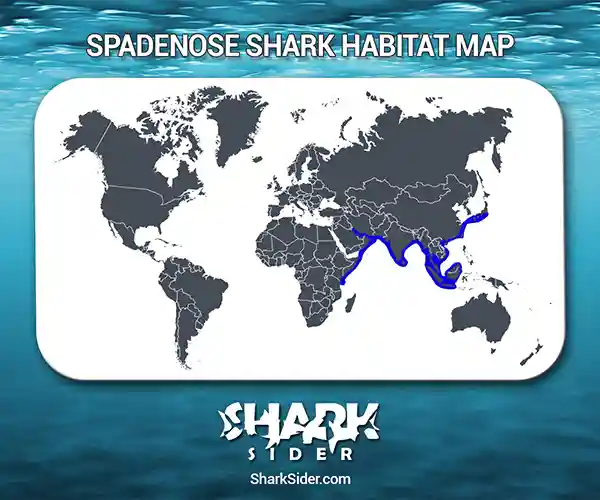The Spadenose shark is a requiem shark found in the tropical Indian and Pacific Oceans. It is named after its distinctive flattened, triangular snout and is a close relative of the hammerhead shark.It has many names, such as Indian dog shark, trowel-nosed shark, yellow dog shark, and mori (in Goa).
This species was first described by German biologists Johannes Peter Müller and Friedrich Gustav Jakob Henle in 1838.
Spadenose Shark Scientific Classification |
|
| Kingdom | Animalia |
| Phylum | Chordata |
| Class | Chondrichthyes |
| Order | Carcharhiniformes |
| Family | Carcharhinidae |
| Genus | Scoliodon |
| Scientific name | S. laticaudus |
Description
The spadenoseshark is not very big, with the maximum length reaching 74 cm (2.4 in). There are reports of a specimen measuring 120 cm (3.9 ft), but they are not confirmed.
It has a broad head with its characteristic flat, trowel-shaped snout and small eyes. There are 25-33 rows of teeth in the upper jaw and 24-34 in the lower jaw. Its back is bronze-gray with a white belly. The fins may be darker than the body.
The pectoral fins appear short and broad. There is no ridge between the dorsal fins. The first dorsal fin is placed nearer to the pelvic fin. The second dorsal fin is considerably smaller than the anal fin.
Where do they live
Map Of The Spadenose Shark’s Habitat

Spadenosesharks inhabit the western Indo-Pacific from Tanzania to South and Southeast Asia. They occur as far east as Java and Borneo and north as Japan and Taiwan. They are also frequently found in the lower reaches of rivers in Sumatra, Malaysia, and Borneo. However, it is unclear whether they are tolerant of fresh water. They commonly inhabit shallow waters near the coast 10-13 m (33-43 ft) deep, close to rocky bottoms.
Behavior
Dietary
It feeds primarily on small bony fishes and invertebrates. Its main prey includes anchovies, Bombay ducks, codlets, shrimp, crabs, and cuttlefish.
Reproductive
The spadenose shark exhibits the most advanced form of placental viviparity among all fish species. Breeding takes place year-round, though females typically mate only once a year.After 5-6 months of gestation, the female gives birth to 6-18 pups.
Newborn sharks measure between 12 and 15 cm (4.7-5.9 in). Male sharks reach sexual maturity at a length of 24-36 cm (9.4-14.2 in), and females become sexually mature at 33-35 cm (13-14 in). Both sexes are thought to mature at 6-24 months. Estimates put the average lifespan at five years for males and six years for females.
Social
They are social fish commonly found hunting in schools near the coast.
Adaptations
Like most species of shark, the spadenose shark has a streamlined body for smooth movement, an acute sense of smell and vision, and sharp, blade-like teeth for ripping into prey.
Human interactions
Spadenose sharks are harmless to humans. They are caught in significant quantities by various methods, such as trawlers, longlines, fish traps, gillnets, bottom nets, and hook-and-line. They are usually used for human consumption, such as shark fin soup, or processed into fishmeal and fishing baits. The meat can also be processed using glacial acetic acid, resulting in a gel powder used in cereal foods as a protein supplement and as a binder in sausages. This gel is also used as a biodegradable film for wrapping fish meat.
Despite being commercially important, there is a lack of data regarding the effect of fishing on its population. The IUCN has declared this species as “Near Threatened” or “NT.”
